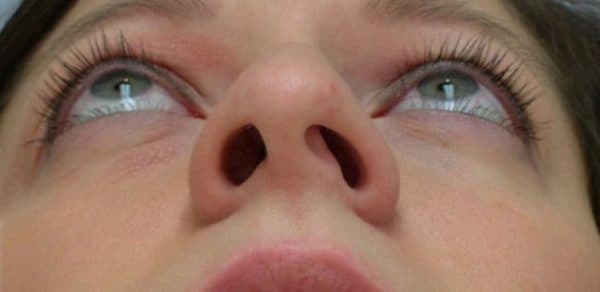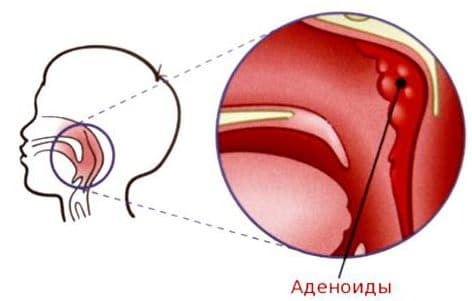
The nasal septum divides the nasal cavity into two symmetrical parts. Newborn children have a flat and straight plate. Its structure is completely cartilaginous tissue, on which minor ossification is present. With the growth of the organism, the bony foci pass into the bone, join together into one bone. This formation process ends by 10 years.
For an adult this structure is characteristic: the front part of the plate is cartilaginous tissue, and the posterior part is a thin bone. Both sides are lined with a mucous membrane. But an even partition is extremely rare. Most often it is twisted, and it can happen for various reasons.
Contents
- 1 Reasons for adults
- 1.1 Physiological
- 1.2 Compensatory
- 1.3 Traumatic
- 2 What affects the development of deformity in children
- 3 Degrees
Causes in adults
Before prescribing treatment, the physician must conduct an external examination of the patient, and determine the underlyingfactor, which was the cause of the emergence of pathology. Today, these reasons are diverse.

On photo-curvature of nasal septum in adults
Physiological
These causes are interrelated with the growth of the skull bones or birth defects. The most common include:
- The bone of the brain and facial sections of the skull grew unevenly .With the active development of the medulla, the nasal cavity narrowed, as a result of which the plate curved.
- The uneven development of the bony and cartilaginous tissue of the nasal septum .This indicates that the bone tissue was actively growing, with the deformation being susceptible to the nasal plate, consisting of cartilaginous tissue.
- Increased growth of the rudimentary organ of Jacobson. It is concentrated in the olfactory part of the nose. Presented as a cluster of neural tissue. If it actively grows, it is a direct way to a limited space for the normal formation of the nasal plate and, as a result, to its curvature.
On video reasons of curvature of nasal septum:
Compensatory
These reasons for the development of pathology are associated with the fact that the nasal cavity forms various formations, which include:
- Hypertrophy .There is an intensive formation of one and nasal concha. As a result, the increased size of the shell presses on the plate, causing it to deform.

On the photo - hypertrophy of the nose
- The presence of polyps and a tumor on the nasal mucosa .If the neoplasms strongly expand, then they obscure one of the nostrils. Thus, nasal breathing is disrupted, and the plate itself is deformed, as it attempts to eliminate this condition.
Traumatic

These causes depend on the injuries that led to the displacement of the nose bone and the curvature of the plate. Most often, pathology is diagnosed precisely in boys in their teens and men. This is the category of people whose skull and face injuries are most common .Because of a strong impact, the displacement of the bones of the nose is observed.
This leads to deformation of the nose plate, and it can occur, even if the blow was not too strong. Affect the development of the most severe deformities can be an incorrect fusion of the bones of the nose after the fracture suffered.
What influences the development of deformity in children
Difficulty in breathing in through the nose is a problem that is often diagnosed in infants. Since the baby has not yet learned to breathe through the mouth, there is a violation of the feeding process, and at night it is very poorly awake.
Many parents associate the nasal congestion of their child with dry air in the room, frequent ARI and air pollution. Of course, these factors have their influence when the baby breathes in through the nose. But they are temporary.
 How treatment of snoring with sea buckthorn oil, and how effective this tool is, is described in great detail in this article.
How treatment of snoring with sea buckthorn oil, and how effective this tool is, is described in great detail in this article.
How to make a recipe for aloe from a common cold for an adult is described in detail in this article.
But what antibiotic is better for purulent angina adult, will help to understand this article: http: //prolor.ru/g/lechenie/ antibiotiki-pri-gnojnoj.html
Perhaps you will also be interested to know what to do at home when your nose is broken.
But when the nasal congestion is observed for a long period of time, it is most often associated with this pathology, like the curvature of the septum.
As mentioned earlier, this is a plate that consists of cartilaginous tissue and a thin bone. She will divide her nose into two parts. Only in children this plate is more elastic and soft, which makes it sensitive to injury and damage. And, as you know, children love active games, as a result of which, and there are blows or falls on the face.
On video, which affects the development of deformation of the nasal septum in children:
The nasal septum finally develops to 10 years. If there is a slight deformation, then this is the norm. At the same time, the child breathes fully and does not feel any marked symptoms.
The following factors can affect the development of pathology in children:
- trauma in childbirth;
- uneven development of the bones of the skull due to the rapid formation of the cartilaginous tissue of the nasal cavity;
- the presence of a polyp or other malignancy that grows in the nose and presses against the plate;
- is an inflammation that leads to a thickening of the nasal plate in the cartilage zone;
- curvature of the nose after injury - fracture.
It is possible to detect an uneven septum in a child at any age, so the age here is not a hindrance. Here everything depends on the severity of the symptoms. The baby can live normally during the entire childhood with an uneven septum without visible symptoms. But already, as an adult, the clinical picture takes on more pronounced outlines.
It will also be interesting to learn about how to understand whether a nose is broken or not, and what signs should be paid attention in the first place.
What signs of a broken nose in a child are found most often, is described in great detail in this article.
You may also be interested in learning how polyps are treated in the throat.
What symptoms of cysts in the nose occur most often, and what drugs are most effective in dealing with this problem, will help to understand this article.
It will also be interesting to learn about how a cyst is treated in the nose without surgery.
Degrees
There are several classifications of curvature of the septum, among which the type of pathology is distinguished by the nature of its severity. Thus, the curvature of the plate can be 1, 2 or 3 degrees. For the first degree, the deformation from the conditioned line of the middle of the nose is insignificant. At the second degree, the protruding plate takes half the distance from the midline and to the lateral surface of the nasal cavity. But the third degree implies the almost touching edge of the septum of the lateral side of the nasal cavity.
On video degree of curvature of nasal septum:
If a patient is diagnosed with a pathology of 1 degree, then special treatment is not necessary here. This condition occurs in most people. And here already deformation of 2 or 3 degrees require carrying out of therapy as are characterized by the expressed symptomatology and complications. And do not delay with treatment, because this can lead to the fact that neighboring organs will be involved in the pathological process.
There can be a variety of reasons for influencing the development of the curvature of the septum. But among the most common - trauma or birth defect. In any case, it is necessary to see the doctor so that he can assess the extent of the pathology. If during the diagnosis it was found that the curved septum does not prevent a person from fully working and living, then no steps to treatment will be taken.
